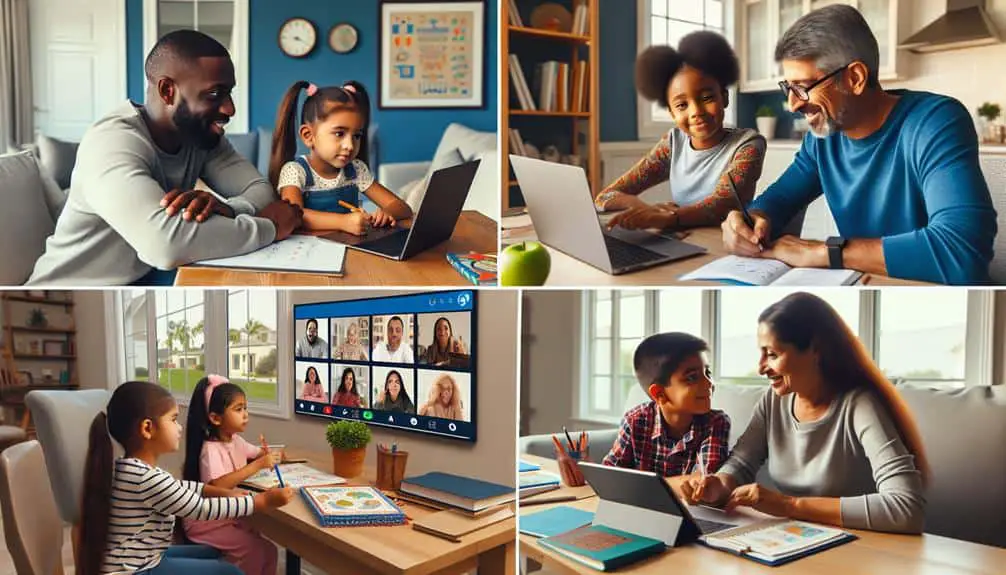To enhance your homeschooling journey, strategically integrate technology for dynamic learning. Guarantee interactive lessons cultivate hands-on experiences and personalized learning. Encourage active participation and immediate feedback. Maximize outcomes by selecting appropriate tech tools and involving parents. Set boundaries on screen time, monitor progress, and offer tailored learning opportunities. Choose educational apps aligned with learning objectives, focusing on subjects and interactivity. Utilize varied online resources for immersive experiences, including virtual field trips. Manage screen time effectively with strategies, boundaries, monitoring, breaks, and tech-free zones. Embrace the latest tech advancements to elevate your homeschooling experience.
Key Points
- Interactive lessons foster dynamic learning environments for homeschooling.
- Parent involvement is crucial for effective tech integration in homeschooling.
- Select appropriate educational apps to enhance personalized learning experiences.
- Utilize online resources like virtual field trips and interactive quizzes for engaging lessons.
- Implement effective screen time management strategies to prevent digital fatigue and ensure productive use.
Benefits of Tech Integration in Homeschooling
Enhancing homeschooling with technology fosters a dynamic learning environment that cultivates creativity and critical thinking skills in students. Interactive lessons and digital engagement provide opportunities for hands-on learning experiences that cater to various learning styles. Through personalized learning, tech tools can adapt to individual student needs, offering tailored instruction and pacing to optimize comprehension and retention.
Digital engagement encourages active participation and immediate feedback, fostering a deeper understanding of concepts. Interactive lessons allow students to explore topics in depth, encouraging curiosity and independent discovery. Personalized learning through tech tools enables students to progress at their own pace, ensuring mastery before moving on to more complex topics.
Best Practices for Homeschool Tech Use
Utilize technology strategically in your homeschooling approach to maximize learning outcomes and student engagement. Parent involvement plays an essential role in the effective use of technology for homeschooling. Parents should actively participate in selecting appropriate tech tools, setting boundaries on screen time, and monitoring progress. By being engaged, parents can make sure that technology is being utilized in a productive manner that aligns with their child's educational needs.
Furthermore, leveraging technology in homeschooling provides personalized learning opportunities. Tailoring educational content to suit individual learning styles and paces can greatly enhance the learning experience. Educational apps and online resources can be customized to cater to each child's strengths and weaknesses, fostering a more engaging and effective learning environment.
Incorporating technology in homeschooling not only allows for personalized learning but also strengthens the bond between parents and children through shared educational experiences. By embracing technology with a strategic mindset and active involvement, parents can create a dynamic learning environment that maximizes their child's potential.
Choosing the Right Educational Apps
When selecting educational apps for homeschooling, consider the specific learning objectives and preferences of your child to guarantee maximum engagement and academic growth. App selection plays an essential role in enhancing the digital curriculum for homeschooling.
To make the right choice, start by identifying the subjects or skills your child needs to focus on. Look for apps that align with these areas while also catering to your child's learning style. Interactive apps can be particularly beneficial as they offer hands-on learning experiences that can boost comprehension and retention.
Additionally, consider the level of difficulty and the potential for progression within the app. This ensures that your child remains challenged and continues to advance. Reading reviews and seeking recommendations from other homeschooling parents can also provide valuable insights into the effectiveness of different educational apps.
Enhancing Learning With Online Resources
Consider integrating a varied array of online resources to augment your homeschooling curriculum and provide a thorough learning experience for your child. Virtual field trips offer immersive experiences that can transport your child to different parts of the world, enhancing their understanding of various subjects.
Interactive quizzes can be used to assess their knowledge and reinforce concepts in a fun and engaging way. Multimedia projects allow your child to showcase their creativity and learning in interactive formats. Encourage them to create presentations, videos, or podcasts to demonstrate their understanding of different topics.
Digital portfolios provide a way for your child to compile and showcase their best work over time, creating a comprehensive record of their educational journey.
Managing Screen Time Effectively
To guarantee a balanced approach to incorporating technology in homeschooling, it's essential to establish effective strategies for managing screen time and promoting healthy digital habits for your child. Setting boundaries is vital in ensuring that screen time is productive and doesn't overshadow other essential activities.
Begin by defining specific time frames or situations where technology can be used for educational purposes. Monitor usage regularly to track how much time your child spends on screens and adjust limits as needed to maintain a healthy balance.
Incorporating breaks between screen time sessions can help prevent digital fatigue and encourage physical activity. Encourage your child to engage in offline activities that stimulate creativity and social interactions.
Additionally, consider implementing tech-free zones in your home to promote face-to-face communication and family bonding without distractions.
Frequently Asked Questions
How Can Parents Address Socialization Concerns in Homeschooling?
To address socialization concerns in homeschooling, you can plan socialization activities like group sports, clubs, or field trips for your child. Community engagement through volunteering or joining local organizations also fosters social development.
What Are the Potential Drawbacks of Heavy Tech Use in Homeschooling?
When it comes to homeschooling, aim for a healthy mix of screen time. Balance is key to maintain engagement in learning. Too much tech can hinder social skills, creativity, and physical activity. Aim for a healthy mix.
How Can Homeschooling Parents Ensure Cybersecurity for Their Children?
To safeguard cybersecurity for your children in homeschooling, implement parental controls for online safety. Regularly monitor their online activities and provide education on internet safety. Stay vigilant and engage in open discussions about potential risks and safe online practices.
Are There Specific Guidelines for Incorporating Physical Activity Into Homeschool Tech Routines?
To incorporate physical activity into homeschool tech routines, try scheduling outdoor breaks for fresh air and movement. Additionally, consider adding dance breaks to keep energy levels up and promote physical fitness while homeschooling.
How Can Parents Handle Technology-Related Distractions During Homeschooling Sessions?
When handling technology-related distractions during homeschooling sessions, you can maintain focus with parental supervision and setting screen time limits. Create tech-free zones to minimize distractions and foster a conducive learning environment for your child.



